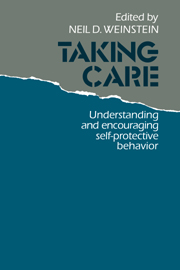II - Research and prevention programs for specific hazards
Published online by Cambridge University Press: 03 February 2010
Summary
The preceding section of this volume offered theoretical perspectives that apply to any situation in which people face the threat of harm. The chapters in this section, in contrast, describe the findings of research and actual prevention programs in several specific fields: health promotion and disease prevention, natural hazards, crime prevention, consumer safety, and occupational safety and health. This group of topics does not exhaust the possibilities for self-protective behavior in our lives. Financial planning, contraceptive use, antiwar protests, and environmental action are other steps that people may take to reduce their risk of being harmed. Nevertheless, the topics included here cover many different hazards and a wide variety of protective actions. The relevant literature is vast.
Each of the general topics of health, natural hazards, and crime is represented in this section by several chapters. The first chapter in each of these subsections attempts to answer the question, Why do people take precautions against this hazard? The second chapter (two additional chapters in the case of health) describes the kinds of programs that have attempted to encourage protective behavior and summarizes our knowledge of what works best. Consumer safety and occupational safety and health are discussed in separate chapters that emphasize actual program experience. The task accepted by these authors was difficult. Within a few pages they attempt to give a comprehensive overview of their topic that is current, accurate, and yet understandable to readers who are not familiar with that particular hazard.
- Type
- Chapter
- Information
- Taking CareUnderstanding and Encouraging Self-Protective Behavior, pp. 115 - 118Publisher: Cambridge University PressPrint publication year: 1987



